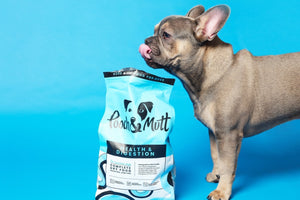
FREE UK DELIVERY ON ORDERS OVER £39.99
The older a dog, the more likely they are to develop an issue with their bones and joints and studies have shown a high incidence of chronic osteoarthritis in our senior pets. Whether or not your dog will be affected is influenced by a number of factors including their lifestyle, weight and genetics; with breeds such as the Labrador, German Shepherd and Bulldog being over-represented.
Unlike humans, dogs don’t have the option of using crutches or wheelchairs. On top of this, their days are spent walking and running rather than sitting on the sofa watching TV and filling in crossword puzzles. They like to keep active, even in their old age.
Dog joints (and puppy joints) are lubricated with a small amount of fluid and covered with a layer of cartilage. This enables free and smooth movement.
As dogs get older, this layer of cartilage often becomes thinner, causing the surfaces of the bone to rub together and resulting in discomfort.
Owners will often bring their dog to the vet when their pet has been getting stiffer and slower and is having some trouble getting about. They may have noticed this change for weeks or months and felt it was ‘part of the normal aging process’. While many dogs can and do get arthritis, there is lots we can do to help them before it gets to this stage.
Preventing joint disease and treating it in its early stages can hugely impact a dog’s quality of life. Doing all we can to support our dog’s joint health can help them lead fuller and longer lives.
Dog joint supplements often contain ingredients that can not be made in the body, which is why they need to be incorporated into a dog diet. Humans suffering from joint problems often take supplements such as glucosamine, chondroitin, and Omega 3, which benefit dog joints, and puppy joints, in a similar way.
Dogs will rarely vocalise in pain or refuse to walk. They are stoic creatures that tend to ‘just get on with it’. Even when in quite a lot of pain, dogs will still run after their favourite ball or rush to greet us when we arrive home from work. Signs of joint pain can be subtle and will include:
Oftentimes, it is the luck of the draw. A dog’s genetics will determine a lot when it comes to their health and some will be more prone to developing diseases like hip dysplasia, spondylosis and osteoarthritis. Pedigrees such as the German Shepherd, Labrador Retriever and Rottweilers tend to be most predisposed. However, joint disease can happen to any dog.
Things like previous injuries, exercise, lifestyle, weight and diet will all play a role. The older a dog is, the more likely that they will have some degree of joint disease.
While we cannot typically prevent or cure joint disease, it can be slowed down and managed. If you have a breed that is known for developing joint disease or you know their parents suffered, it is important to be pro-active.
Things that can help include:
When you are considering a joint supplement, it can be hard to know which one to go for. There are lots on the market, all claiming similar things. It is important to look at the recipe, to ensure the product contains proven ingredients that have been thoroughly researched.
Do also ensure the supplement is in a form your dog will actually eat. Some dogs dislike fish flavours while others won’t take capsules. Our Pooch and Mutt Daily Joint Supplements are in tablet form and can be crushed or crumbled onto meals. They’re highly palatable and can even be given as a treat!
They contain ingredients which have been scientifically proven to prevent joint disease and support those with existing joint issues.
Glucosamine & Chondroitin: Dog joint supplements often contain these ingredients as Glucosamine is needed to form the synovial fluid, which is the joint’s natural lubricant. It is also vital for cartilage metabolism and the renewal of connective tissue in and around dog joints. Glucosamine also provides dog joints with the building blocks needed to manage damage caused by wear and tear and the natural ageing process. Chondroitin works alongside glucosamine, helping to draw fluid and nutrients into the joints. Several research studies have proven that glucosamine and chondroitin can have a positive clinical effect on dogs with arthritis. The ‘dream team’, these supplements can cause improved weight bearing and reduced pain. Long-term, they can decrease the amount of pain relief a dog requires to keep them comfortable; now that really is something!
Vitamin C: This powerful antioxidant can reduce inflammation within diseased joints. On top of this, it is needed for collagen synthesis. Collagen is what makes up cartilage; the body’s natural shock absorber that protects joints.
Type II Collagen: Type II Collagen is easier for the dog’s body to use than other types and specifically targets the joints. It can repair damaged cartilage and studies have shown very promising results. Those in studies demonstrated reduced lameness and pain. Interestingly, stopping the supplement reversed these effects. So, it is important that these supplements are continued lifelong.
Omega 3: Dog joint supplements such as Salmon Oil are a rich source of Omega-3 fatty acids that help with the dilation of blood vessels. They support cardiovascular and brain health, and have also been seen to reduce inflammation and muscle pain, and help tissue repair.
Alongside dog joint supplements, choosing food with ingredients tailored to help dog joints is a great way to maintain healthy joints. Pooch & Mutt's Joint Care grain-free food has helped lots of dogs lead happy, healthy lives. It includes Omega 3, green-lipped mussel, glucosamine and chondroitin. The food is based on 45% Scottish Salmon - one of natures richest sources of Omega 3! With added rosehips, linseed, alfalfa and yucca - all added to support dog joints and mobility.
When it comes to exercising a dog with joint problems; keep activity short but regular. A gentle walk between 15-30 minutes 5 days a week is a good general starting point. Swimming is also a great option for dogs who struggle with mobility, as the water supports the body weight and prevents sudden excessive movement. Swimming can help improve muscle tone, cardiovascular stamina, and improve the range of movement in the joints. If your pooch is a little on the heavier side, hydrotherapy is especially useful for addressing obesity.
While some degree of joint disease may be inevitable in many of our four-legged friends, the above article shows a number of things we can do to slow the onset of this and to help them live as normal a life as possible.





Never miss a treat!
Subscribe to our newsletter and get blog articles amongst other treats delivered to your inbox

Comments (4)
Hi I already use your salmon oil for my Ridgebacks coat, I was looking to add a joint support supplement to that but dont want to give too much oil as i noticed the joint supplement also contains salmon oil, can you asvise it i should lower the dose of oil on its own or if it would not be over kill to give both, she has no mobility issues, i am just looking to support what she has
Hi Rachael! You can absolutely feed both together, we would recommend following the feeding guidelines for each and monitoring for any unwanted side effects. Some dogs take really well to an increase in Salmon oil, whilst others only need a small amount :)
😭 Please can I ask for your advice P&M ? Having struggled with our Dog Mr Will for over 7 years with feeding only to find out that 99% of his problems was allergies. We have an amazing relationship with our Vet who saved Mr Wills life when we rescued him at 7 weeks old. We have had a constant battle in feeding him because he had been diagnosed with Anorexia which manifested as his dislike to food and not wanting to eat at anytime. We have literally tried every product and diet on the market and it was after we realised allergies (chicken, beef, lamb, pork, dairy, grain) were the greatest problem, was when I did extensive research and found your products. Will eats human grade Venison, Ostrich, Duck and Turkey which is cooked fresh daily as he will only eat late evening once per day. He now eats in addition to the fresh meat P&M dried food suitable with his allergies. This is where I request your help. On Friday 21st July we had to rush Will to his Vet with 10/10 lameness on his left rear leg. After X-rays we have been told his Cruciate Ligament is frayed badly and we are heartbroken. We have been giving Will your Joints Supplements for 2 months and we have started trying to add the mobile bones with his meat but it’s very hit and Miss if he eats it. He won’t entertain the salmon oil which we also tried so I have just taken delivery of your Joint Care Dry Food. Could you recommend any other supplement and advise me on how many Joint Supplements I can safely give him to try and help him before we have to make the decision to go down the invasive surgery route which we are not comfortable with at this period of time. We would prefer to go down the additional additives and physio route first. Thank You Pooch & Mutt you really have turned Mr Wills life around (before this injury) looking forward to your reply. Kindest regards
Hi Scilla, oh bless Mr Will! We do have our Joint Care tablets which you could add into his diet, these contain additional type II collagen which helps to repair joint cartilage and could certainly help him. In addition to this regular physio and hydrotherapy will help maintain movement and build up muscle around the knee joint to help support it. If you would like any further advise, please do get in touch with the team at [email protected] :)
Leave a comment